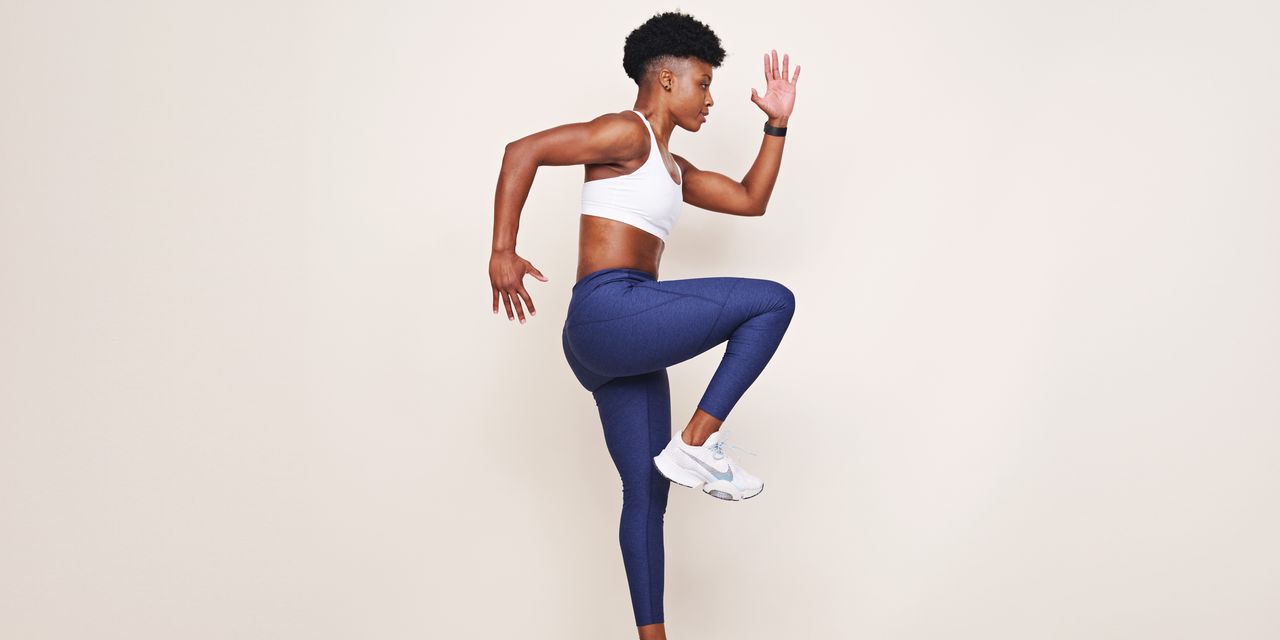Does Running ‘Count’ as a Leg Workout?

You’re out for a long run filled with rolling hills and you start to feel the burn in your leg muscles. It makes sense: You know your lower body is working hard to propel you through your miles.
Yes, your legs can certainly feel cooked after a run. But is that workout enough to replace your lower-body strength session later in the week? Does running ”count” as leg day—or do you need to actually heft some weights to build that strength instead?
Before you decide to skip out on all those reps of lunges, squats, and calf raises, it’s important to understand whether or not running and strength training are interchangeable. Ahead, we tapped fitness experts to settle the debate once and for all, of whether running can actually build just as much muscle and strength as your leg workouts can.
What muscles does running work anyway?
As you might have guessed, pretty much all of your lower body and trunk muscles are involved, whether helping to propel you forward or stabilizing you while running, run coach and physical therapist Victoria Sekely, DPT, CSCS, owner of Train Smart Run Strong, tells SELF. These muscles include:
- Abdominals (front of torso)
- Obliques (sides of torso)
- Glutes (butt)
- Quads (front of thighs)
- Hamstrings (back of thighs)
- Hip abductors (outer thighs)
- Hip adductors (inner thighs)
- Hip flexors (front of hips)
- Gastrocnemius (larger calf muscle)
- Soleus (deeper, flatter calf muscle)
It’s not just about your lower-body, either: Your upper-body muscles come into play, too, as they counterbalance the forces in your torso and help propel you forward via your arm swing, run coach and exercise physiologist Janet Hamilton, CSCS, owner of Running Strong, tells SELF. These muscles include:
- Biceps (front of upper arms)
- Triceps (back of upper arms)
- Pectorals (chest)
- Deltoids (shoulders)
- Trapezius (upper back)
- Rhomboids (upper back)
So what kind of workout is running?
While it’s true that pounding the pavement works your muscles, it’s more of a cardio sesh than a strength workout—especially when it comes to steady-state running. This type of run is lower-intensity and something you can sustain for a longer period of time (think: an hour-long jog at a conversational pace).
“Running is a cardio workout because it challenges the cardiovascular system more so than the musculoskeletal system,” Dr. Sekely says. “Considering this activity is very high rep, it involves more stamina than it does strength.”
Running involves the rhythmic, continual movement of large muscle groups—yep, the ones we mentioned above—which gets your heart pumping. It’s a different kind of work than you’d need to put in if your goal was to build strength: In that case, your body would be tasked with doing fewer reps and sets using heavy weights, Dr. Sekely explains. After all, think of how many total reps of squats you’d do per session. You might max out at 30. But with running, you can do up to 180 reps (okay, steps) per minute!
Physical therapist Emmi Aguillard, DPT, who specializes in treating and training runners, agrees. “While there are some minor strength gains that can be made from running, it’s typically not enough to move the needle in a meaningful way,” she says.
Building strength “typically involves progressively overloading your system by making the exercises progressively more challenging—usually done through increasing weight,” Dr. Sekely says. For instance, exercises that help you build strength are generally done for 2-3 sets of 6-10 reps (or fewer, if max strength is your goal!), using a weight that’s heavy enough for you to only have 1-2 reps left in the tank. Then, of course, you rest to give your muscles a breather before doing it all over again.
Workouts, like running, are considered cardio when your heart rate is elevated above resting (approximately 50-85% of your max heart rate). While the latest Physical Activity Guidelines for Americans report removed the minimum duration of time necessary for these workouts to “count” toward your weekly physical activity total, cardio workouts still typically tend to last about 30 to 60 minutes, Dr. Aguillard says.
Additionally, workouts that increase your heart rate recruit type 1 muscle fibers, Dr. Aguillard explains. These types—a.k.a. slow-twitch fibers—are responsible for endurance movements, like running for longer periods of time, per the National Academy of Sports Medicine (NASM). On the other hand, type 2 muscle fibers (a.k.a, fast-twitch) power anaerobic work, or that which taps into strength and power—yes, like lifting—which can’t be sustained for a long time, Dr. Aguillard explains.
Basically, if a workout is primarily recruiting type 1 muscle fibers, it’s an aerobic workout, Dr. Aguillard explains. And steady-state running falls squarely into that.
But can you build muscle or gain strength with other types of running?
Certain types of running—like hill repeats, strides, and intervals, for instance—can build more muscle and strength than steady-state running, according to Dr. Aguillard. “When you sprint or run uphill, your muscles must contract forcefully to overcome gravity and produce speed, which leads to microtears in your muscles,” she says. When your body repairs these microtears, that’s what causes your muscles to rebuild bigger and stronger, per the NASM.
Sprinting and hills also recruits more type 2 muscle fibers, which are primarily designed for power and explosive efforts. When you sprint, you’re hitting the ground with much more force than slower, steady-state running , and when you run uphill, your muscles (especially glutes, hamstrings, and calves) are working against resistance similar to adding weights to reps at the gym, Dr. Aguillard explains.
These “strength building” runs also share some other similarities with weight lifting, like lasting for a shorter duration and taking time to rest in between, as opposed to steady-state running. You can only sustain these more intense efforts for a shorter time since you’re tapping into your anaerobic system, where you’re using the energy stored in your muscles to power you, rather than the oxygen from the air you’re breathing, Dr. Aguillard explains.
With steady-state running, the impact with each step is so much lower, so there’s hardly any progressive overload happening. As a result, your body simply is not forced to adapt in the same way—unless you run much farther than your typical run, says Dr. Aguillard.
How can you build a balanced fitness routine if you like to run?
Our experts agree you should make room for running and strength training in your weekly routine. “Proper strength training will allow your body to be able to handle more running volume with reduced chance of injury, so you can train harder, run longer, and increase overall volume because of the muscular gains that strength training produces,” Dr. Aguillard says. And yes, that means actual strength training, not penciling in a day of hill climbs.
Hamilton likes to have the runners she coaches do some form of resistance training two to three times a week using their own body weight for resistance or bands, cables, and dumbbells. They don’t have to be marathon gym sessions: Strength training sessions can take as little as 15 to 20 minutes, Dr. Sekely says.
As for what strength training for runners should look like? Runners should do compound exercises that work multiple muscle groups and joints at once (like deadlifts) and isolation moves that target smaller, more specific muscles (like banded clam shells). Additionally, single-leg exercises are key because you’re never on both legs at once during a run.
Because running works your core and upper body, it’s important to add moves like forearm planks, side planks, bird dogs, triceps kickbacks, chest presses, and biceps curls into your strength sessions as well.
One simple way to incorporate strength training into your routine if your schedule allows is keeping “hard days hard” by doing a lower-body workout following a harder run or workout, Dr. Aguillard says. You can also do a lower-body workout the day after a harder run or interval workout.
“It’s certainly important to allow for enough recovery time between both hard runs and lifting days for the body to actually reap the benefits of the workout,” Dr. Aguillard says. “If you’re constantly just breaking down the body without allowing adequate recovery time for the muscles, tendons, ligaments, and bones to adapt, you will not see any sort of gains.”
Related:
- Does Indoor Cycling ‘Count’ as Strength Training—or Is It Just Cardio?
- 10 Running Myths Top Coaches Really Wish You’d Stop Believing
- Why Every Anxious 20-Something Is Running a Marathon Right Now
Get more of SELF’s great fitness content delivered right to your inbox.




